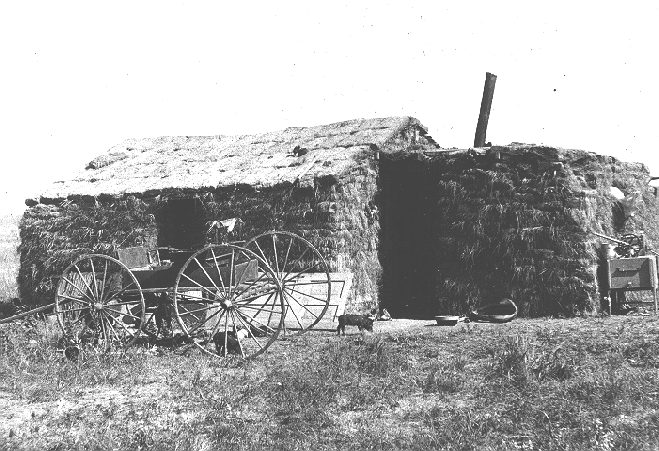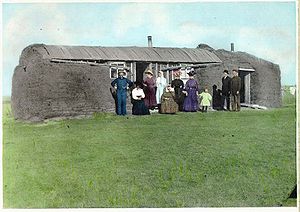
Sod house
Encyclopedia


Canada
Canada is a North American country consisting of ten provinces and three territories. Located in the northern part of the continent, it extends from the Atlantic Ocean in the east to the Pacific Ocean in the west, and northward into the Arctic Ocean...
and the United States
United States
The United States of America is a federal constitutional republic comprising fifty states and a federal district...
. The prairie
Prairie
Prairies are considered part of the temperate grasslands, savannas, and shrublands biome by ecologists, based on similar temperate climates, moderate rainfall, and grasses, herbs, and shrubs, rather than trees, as the dominant vegetation type...
lacked standard building materials such as wood or stone; however, sod
Sod
Sod or turf is grass and the part of the soil beneath it held together by the roots, or a piece of thin material.The term sod may be used to mean turf grown and cut specifically for the establishment of lawns...
from thickly-rooted prairie grass was abundant. Prairie grass had a much thicker, tougher root structure than modern landscaping grass.
Construction of a sod house involved cutting patches of sod in rectangles, often 2'×1'×6" (600×300×150mm) long, and piling them into walls. Builders employed a variety of roofing methods. Sod houses accommodate normal door
Door
A door is a movable structure used to open and close off an entrance, typically consisting of a panel that swings on hinges or that slides or rotates inside of a space....
s and window
Window
A window is a transparent or translucent opening in a wall or door that allows the passage of light and, if not closed or sealed, air and sound. Windows are usually glazed or covered in some other transparent or translucent material like float glass. Windows are held in place by frames, which...
s. The resulting structure was a well-insulated but damp dwelling that was very inexpensive. Sod houses required frequent maintenance and were vulnerable to rain damage. Stucco
Stucco
Stucco or render is a material made of an aggregate, a binder, and water. Stucco is applied wet and hardens to a very dense solid. It is used as decorative coating for walls and ceilings and as a sculptural and artistic material in architecture...
or wood panels often protected the outer walls. Canvas or plaster often lined the interior walls.
In the United States, the terms of the Homestead Act
Homestead Act
A homestead act is one of three United States federal laws that gave an applicant freehold title to an area called a "homestead" – typically 160 acres of undeveloped federal land west of the Mississippi River....
offered free farmland to settlers who built a dwelling and cultivated the land for five years. Related straw-bale construction
Straw-bale construction
Straw-bale construction is a building method that uses bales of straw as structural elements, building insulation, or both...
developed in Nebraska
Nebraska
Nebraska is a state on the Great Plains of the Midwestern United States. The state's capital is Lincoln and its largest city is Omaha, on the Missouri River....
with early baling machines and has endured as a modern building material. Sod houses achieved none of the nostalgia that log cabins gained, probably because soddies were much more subject to dirt and infestations of insects. Early photographs record some sod houses; otherwise, they have all but disappeared from the landscape.
Notable sod houses
Sod houses that are individually notable and historic sites that include one or more sod houses or other sod structures include:Canada
- Addison Sod HouseAddison Sod HouseAddison Sod House is a Saskatchewan homestead site made of grass or sod which is over a hundred years old and has been designated as a National Historic Site of Canada.-History of site:...
, a Canadian National Historic Landmark building, in Saskatchewan - L'Anse aux MeadowsL'Anse aux MeadowsL'Anse aux Meadows is an archaeological site on the northernmost tip of the island of Newfoundland in the Canadian province of Newfoundland and Labrador. Discovered in 1960, it is the only known site of a Norse or Viking village in Canada, and in North America outside of Greenland...
, the site of the pioneering 10th-11th century CE NorseNorseNorse may refer to:In history:* Norsemen, the Scandinavian people before the Christianization of Scandinavia** Norse mythology** Norse paganism** Norse art** Norse activity in the British IslesIn language:...
settlement near the northern tip of Newfoundland, has reconstructions of eight sod houses in their original locations, used for various purposes when built by Norse settlers there a millennium ago
United States
- Leffingwell Camp SiteLeffingwell Camp SiteThe Leffingwell Camp Site, located on a barrier island of the Arctic coast of Alaska, was used by polar explorer and geologist Ernest de Koven Leffingwell in the Anglo-American Polar Expedition of 1906–1908, which aimed to explore the Beaufort Sea...
, Flaxman Island, Alaska, listed on the U.S. National Register of Historic Places (NRHP) - Pioneer Sod HousePioneer Sod HouseThe Pioneer Sod House in Wheat Ridge, Colorado is a sod house built in 1886. It was listed on the National Register of Historic Places in 1973.-See also:*National Register of Historic Places listings in Jefferson County, Colorado...
, Wheat Ridge, Colorado, NRHP-listed - Minor Sod HouseMinor Sod HouseThe Minor Sod House, also known as Minor Post Office, near McDonald, Kansas is a sod house that was built in 1907. It was listed on the U.S. National Register of Historic Places in 2005. It served historically as a single dwelling and as a post office....
, McDonald, Kansas, NRHP-listed - Cottonwood RanchCottonwood RanchThe Cottonwood Ranch is an historic site near Studley in Valley Township, Sheridan County, Kansas, United States. The ranch is now preserved as a Kansas State Historic Site....
, Sheridan County, Kansas; the NRHP-listed historic ranch site included a sod stable - Heman Gibbs Farmstead, Falcon Heights, Minnesota; the NRHP-listed stie includes a replica of the original 1849 sod house
- Gustav Rohrich Sod HouseGustav Rohrich Sod HouseThe Gustav Rohrich Sod House was a sod house located in Bellwood, Nebraska. It was built in 1883 on of land by Gustav Rohrich , an immigrant from Austria, for himself, his wife and three children. Its walls are made of sod laid in blocks, grass side down, with each block approximately 2 to long,...
, Bellwood, Nebraska, NRHP-listed - Wallace W. Waterman Sod HouseWallace W. Waterman Sod HouseThe Wallace W. Waterman Sod House near Big Springs, Nebraska is a sod house built in 1886. It was modified in 1925 for continued use, including a layer of concrete being applied. It was listed on the U.S. National Register of Historic Places in 1995. The listing included two contributing...
, Big Springs, Nebraska, NRHP-listed - Jackson-Einspahr Sod HouseJackson-Einspahr Sod HouseThe Jackson-Einspahr Sod House near Holstein, Nebraska is a sod house that was built in 1881. It was listed on the U.S. National Register of Historic Places in 2006....
, Holstein, Nebraska, NRHP-listed - Sod House (Cleo Springs, Oklahoma)Sod House (Cleo Springs, Oklahoma)The Sod House in Cleo Springs, Oklahoma, also known as Marshall McCully Sod House was built in 1894. It was listed on the National Register of Historic Places in 1970. The Sod House Museum maintains the structure....
, also known as Marshall McCully Sod House, NRHP-listed - Sod House RanchSod House RanchThe Sod House Ranch is a historic ranch in Harney County in southeastern Oregon, United States. The remaining ranch structures are located south of Malheur Lake in the Malheur National Wildlife Refuge. The ranch was built by Peter French, a well known 19th-century cattle baron...
, Burns, Oregon
See also
- BurdeiBurdeiA burdei, or bordei is a type of half-dugout shelter, somewhat between a sod house and a log cabin. This style is native to the Carpathian Mountains and forest steppes of eastern Europe.-Neolithic:...
, a Ukrainian-inspired hybrid between the sod house and the log cabin, used in Western Canada - Canadian PrairiesCanadian PrairiesThe Canadian Prairies is a region of Canada, specifically in western Canada, which may correspond to several different definitions, natural or political. Notably, the Prairie provinces or simply the Prairies comprise the provinces of Alberta, Saskatchewan, and Manitoba, as they are largely covered...
- Cob (building)Cob (building)Cob or cobb or clom is a building material consisting of clay, sand, straw, water, and earth, similar to adobe. Cob is fireproof, resistant to seismic activity, and inexpensive...
- Dugout (shelter)Dugout (shelter)A dugout or dug-out, also known as a pithouse, pit-house, earth lodge, mud hut, is a shelter for humans or domesticated animals and livestock based on a hole or depression dug into the ground. These structures are one of the most ancient types of human housing known to archeologists...
- List of house styles
- Sod roofSod roofA sod roof or turf roof is a traditional Scandinavian type of green roof covered with sod on top of several layers of birch bark on gently sloping wooden roof boards. Until the late 19th century it was the most common roof on rural log houses in large parts of Scandinavia...

